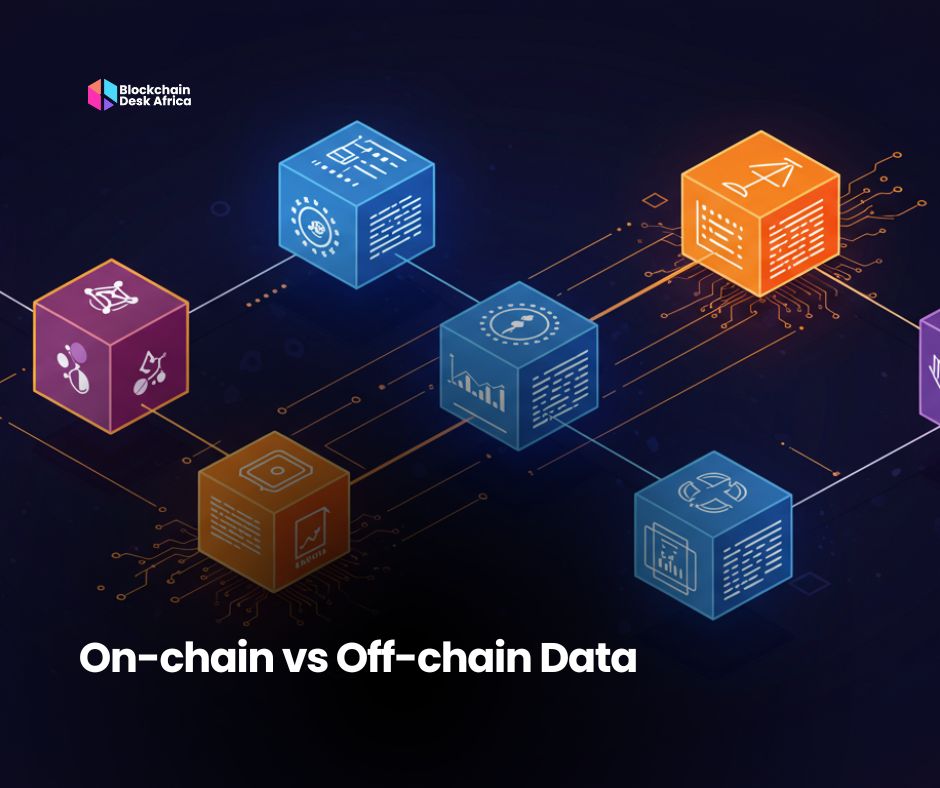Every transaction, NFT mint, or smart contract interaction on a blockchain tells a story , but not the whole story. Much of what powers decentralized applications lives behind the scenes, outside the blockchain itself. This often-overlooked split between what’s stored on-chain and what’s handled off-chain fundamentally shapes the speed, cost, and trust of Web3 systems.
Most people associate blockchain with tokens and transactions. But behind every transfer of value lies a deeper layer: data and not all of it lives on the chain. Understanding where data is stored, and why, is critical for navigating today’s blockchain environment.
On-chain and off-chain data are not just technical choices. They are strategic, architectural decisions that directly impact transparency, scalability, privacy, and compliance. If you want to build or use blockchain effectively, this is one distinction you cannot afford to ignore.
What On-chain data?
On-chain data refers to all information that is recorded directly on the blockchain. This includes transaction histories, smart contracts, token balances, and other publicly verifiable information. On-chain data is immutable, transparent, and decentralized. Once it’s recorded, it cannot be altered or deleted, making it highly secure and trustless.
For example, if you send 0.5 SOL to someone, that transaction is on-chain. If you deploy a smart contract or mint an NFT, those actions are recorded on-chain. This ensures transparency, allowing anyone to verify the activity without relying on a third party.
However, storing data on-chain comes at a cost. Blockchains are designed for consensus and security, not for heavy data storage. Every byte of on-chain data requires validation and replication across all nodes in the network. This makes it expensive and inefficient for storing large or frequently changing datasets.
Off-chain data
This refers to information stored outside the blockchain, often on traditional servers, cloud storage, or specialized decentralized file systems like IPFS or Arweave. Off-chain data can include user profiles, legal documents, medical records, or even the high-resolution image associated with an NFT.
While off-chain storage offers scalability and lower costs, it introduces trade-offs. Chief among them is the need for trust. Because off-chain data isn’t validated by the blockchain, users must trust the data provider. To mitigate this, developers often use hashing techniques to store a fingerprint of the off-chain data on-chain. This way, users can verify that the off-chain content hasn’t been tampered with.
In practice, many blockchain applications use a hybrid model. For instance, a decentralized social media platform may store post metadata on-chain (like time and user ID) but keep the actual content off-chain. This allows the system to remain efficient while benefiting from blockchain’s transparency and trust guarantees.
Why does this distinction matter?
The distinction impacts everything from scalability and cost to security and user privacy. Developers must decide which data deserves the permanence and transparency of the blockchain and which is better managed off-chain.
The decision is also important for compliance with regulations like General Data Protection(GDPR), which gives users the right to have their personal data deleted. Since on-chain data is immutable, storing sensitive or identifiable data on-chain can lead to legal challenges.
Each approach comes with advantages and disadvantages.
Pros and Cons of On-chain vs Off-chain Data
Let’s break down the core trade-offs more clearly:
On-chain data– Advantages:
- Immutability: Once recorded, data cannot be changed or deleted, which ensures a verifiable and tamper-proof audit trail.
- Transparency: Anyone can inspect transactions and contract logic, fostering trust and openness.
- Security: Data secured by consensus across decentralized nodes is far less vulnerable to unauthorized manipulation.
- Trustlessness: Eliminates the need for intermediaries to verify or authenticate information.
On-chain data – Disadvantages:
- High cost: Storing even small amounts of data on-chain can be prohibitively expensive, especially on networks like Ethereum.
- Scalability limits: Blockchains aren’t designed for high-volume or high-frequency data storage. Large datasets can slow down the network.
- Inflexibility: The immutability that brings security also poses challenges in cases where data must be updated or removed (e.g., for legal compliance).
Off-chain data – Advantages:
- Cost-efficient: Data can be stored cheaply using centralized or decentralized file systems, without the computational burden of blockchain validation.
- Scalable: Ideal for large files (videos, documents, metadata) and frequent updates, without congesting the blockchain.
- Private and flexible: Data can be modified or deleted as needed, aligning better with data protection laws and user expectations.
Off-chain data – Disadvantages:
- Trust dependency: Since data isn’t secured by the blockchain itself, users must trust the storage provider or application backend.
- Risk of data loss or manipulation: If not paired with proper verification (e.g., hashing), off-chain data can be altered without detection.
- Centralization concerns: Depending on the infrastructure used, off-chain solutions may reintroduce single points of failure or censorship.
Final Thoughts
Understanding this balance between on- chain and off-chain is essential. Projects need to deliver efficient and secure solutions without overburdening networks or users. Smart use of on-chain and off-chain data can enable everything from decentralized ID systems to supply chain transparency without compromising performance.
Additionally, on-chain data is increasingly being used for analytics, credit scoring, and reputation building. Platforms that can read and interpret on-chain behavior have a significant edge in designing personalized services or targeted products. Meanwhile, off-chain storage allows for localized, private, or proprietary information to remain confidential yet accessible when needed.
On-chain and off-chain data serve different purposes, each with its strengths and limitations. A well-architected blockchain solution knows how to balance the two, delivering systems that are transparent, scalable, and fit for purpose in Web3.
